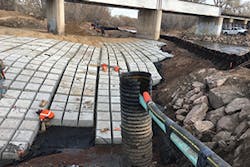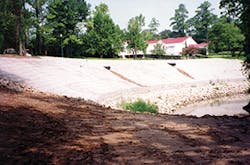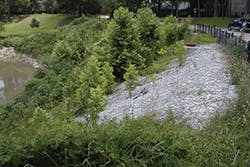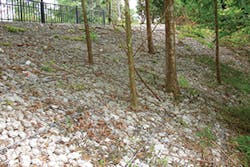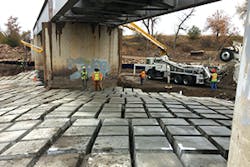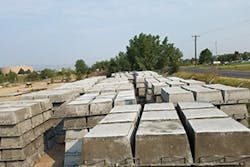Perhaps nothing tests the stabilization of a channel or streambank like a significant flood event, such as Hurricane Harvey delivered in 2017. Such events highlight whether a long-established gabion installation has withstood the test of time.
Buffalo Bayou
“We’ve had no gabion failures anywhere on any bayous in Houston from any of the storm events we’ve had since the 1995 installation of the Piney Point project,” notes Maury Shepherd, president of C.E. Shepherd (Modular Gabion Systems), of a project for which his company had provided a solution.
“They’re doing their job very inconspicuously, but they haven’t suffered any damage at all from any of the weather events that have happened,” he adds.
In a 1995 erosion control mitigation effort in Houston, both gabions and gabion mattresses were put in place on the Buffalo Bayou Channel, with a gabion toe wall and mattress on the project’s slope, notes George Ragazzo, general manager and erosion and flood control specialist for Modular Gabion Systems.
Aside from stabilizing the bank of the channel, the approach resulted in vegetation being well-established on the slope, says Ragazzo, adding that “trees even grew through the gabion mattress.”
Modular Gabion Systems teamed with Regency Construction on the privately owned land at the request of the US Army Corps of Engineers. While the waterway provides a pleasant retreat for residents, it also collects runoff from a watershed encompassing more than 500 square miles in a city that receives more than 40 inches of rainfall annually, notes Ragazzo.
Trees and other vegetation have grown on the reinforced slopes at Piney Point since 1995.
The rain frequently comes in torrential downpours, causing the bayou to rapidly swell with floodwaters that had scoured away banks and vegetation. Previous efforts to control flooding and erosion along Buffalo Bayou were at best temporarily successful.
Erosion had posed a threat to homes, and in particular, the erosion at Farnham Park threatened residences in Piney Point Village. The Corps of Engineers sought a solution that would be pervious and flexible, designing a streambank erosion control structure using Modular Gabion Systems’ gabion baskets and mattresses.
The streambank protection began with a toe wall of gabion baskets topped by a bank of mattresses. The structures are able to conform to changes in the underlying terrain and are self-draining to alleviate hydrostatic pressure that could otherwise lead to project failure.
Soon after construction was completed, silt and dirt settled in the spaces of the rock fill, which provided a soil base for natural revegetation. Roots, rocks, and mesh eventually formed a web that prevents fast-moving water from pulling up tender vegetation.
The company has since executed a half-dozen projects on Buffalo Bayou and other bayous in Houston, says Shepherd. The Piney Point project remains unscathed through the myriad weather events that have occurred since 1995.
“You don’t even know it’s there,” he says. “It is so completely revegetated, except for the upper edges of the project where the residents keep the brush down so they can see through the trees down to the bayou and across to the other side.”
“It is completely revegetated with indigenous species and things that have washed down and taken root,” he says. “From the bayou, it looks like a natural bank. You can’t tell there are gabions there because it’s got low vegetation—grass—and then it has trees that are eight to ten inches in diameter growing up through it. This kind of revegetation dramatically improves the performance of gabions, but they’ve got to last long enough for that to happen.”
Maccaferri gabions are cages engineered from double-twisted hexagonal woven steel wire mesh, assembled and filled at the project site.
Davide Invernizzi of Maccaferri notes that the mass gravity retaining wall was needed because the high flow and high volume of water coming from the creek necessitated a robust structure.
The solution needed to maintain the integrity of the slope and protect a private home located above it while at the same time dissipating energy from the high flows and volumes of water in the creek.
The gabion wall, 9 feet high with a 9-foot base and 3-foot steps, has enough mass and porosity to reduce the velocity of the water. Bernall Construction installed the wall, including Maccaferri PVC-coated gabion baskets, stainless steel hog rings, and MacTex N, a nonwoven geotextile. S. J. Louis Construction served as the general contractor.
A year after the installation, Invernizzi says new vegetation is established and the gabions are performing successfully, even through storms and rains that occurred shortly after construction.
ACBs in the channel beneath the bridge
Building a Bigger Block
A combination of a high-velocity flows and an unusual amount of heavy debris such as large trees were factors of concern in a channel stabilization project connected with railroad bridge repairs in Fort Carson, CO.
Charlie Chase, president of US sales for International Erosion Control Systems (IECS), explains that the project’s focus was to protect the footings of the railroad bridge from erosion caused by the creek. The project designers wanted protection with a heavy footprint.
The Omaha District of the US Army Corps of Engineers came up with an idea of stacking two of the same type of articulated concrete blocks (ACBs) from IECS on top of each other in an effort to double the pounds per square foot, adding more stability to the channel, notes Chase. However, believing the blocks would work better as a single unit rather than two blocks stacked and connected together, IECS developed a novel way to pour a new block that was twice the thickness of the company’s old blocks to accommodate the Corps’ request.
The 3-foot-square and 16-inch-high blocks are believed to have the largest footprint of any ACB within the industry. To the best of his knowledge, “this is the thickest block that has ever been manufactured in Canada or the US,” says Chase.
He adds, “This is a channel that requires a special block due to super-critical flows and large debris being flushed down it. It also is going under a train trestle with large concrete columns holding it up, and the flow increases in these areas.”
Production of the new blocks began in summer 2017, with IECS producing the mats onsite, saving considerable amounts of freight for the government.
Matt Olbrantz, quality control manager for MASS Service and Supply, the general contractor on the project, says the installation of the specially fabricated IECS ACB was relatively easy. “Our installing contractor hadn’t done anything like this before, and while there was a little bit of a learning curve in the beginning, once they got going, everything moved pretty quickly and easily.”
The solution has the potential to open a new market for articulated concrete mats, Chase adds.
